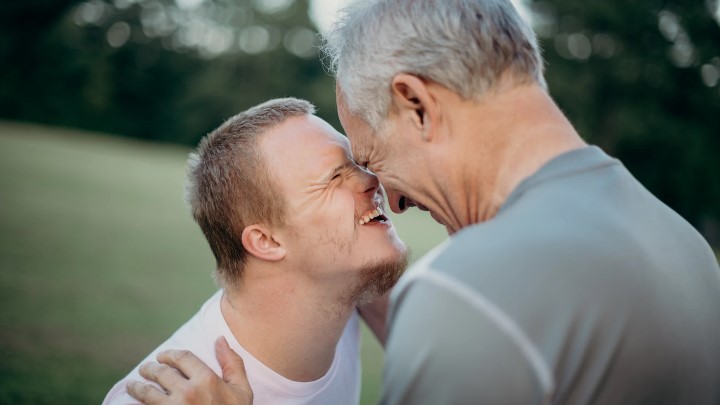When observing individuals with Down Syndrome, you may notice certain similarities in their physical features. It is essential to approach this topic with empathy and understanding, recognizing that these physical characteristics do not define the unique beauty and individuality of each person.
In this article, we will examine why do people with down syndrome look the same. The reasons behind the similarities in appearance among individuals with Down Syndrome, highlight the importance of celebrating diversity and embracing the inherent worth of every individual.
You can also learn how to help specail needs kids to stop tiptoe walking.
The Genetic Basis of Down Syndrome
Understanding Chromosomal Abnormality
Down Syndrome, also known as Trisomy 21, is a genetic condition caused by the presence of an extra copy of chromosome 21. This additional genetic material alters the course of development and contributes to certain physical characteristics associated with Down Syndrome.
The Extra Copy of Chromosome 21
The extra copy of chromosome 21 in individuals with Down Syndrome disrupts the usual genetic balance, leading to specific physical traits. These traits are not identical among all individuals with Down Syndrome but can create a resemblance that may be perceived as a similarity in appearance.
Physical Characteristics Associated with Down Syndrome
Facial Features
Individuals with Down Syndrome may exhibit certain facial features that contribute to the perception of similarity. These features can include almond-shaped eyes, a small nose, a flat facial profile, a small mouth, and a protruding tongue. However, it is important to remember that these features vary in degree and expression among individuals and should not be used as the sole basis for identifying or defining a person with Down Syndrome.
Body Structure and Growth
People with Down Syndrome may also share certain body structure and growth patterns. These can include shorter stature, decreased muscle tone, a broader neck, shorter limbs, and differences in hand and foot shape. These physical characteristics, while observable, should not overshadow the unique qualities, abilities, and personalities of individuals with Down Syndrome.
Embracing the Individuality Within Similarities
Recognizing the Beauty of Diversity
While there may be similarities in appearance among individuals with Down Syndrome, it is crucial to recognize and celebrate the diversity within this community. Each individual possesses their own unique personality, talents, interests, and strengths that go far beyond physical appearance. By focusing on the individuality and inherent worth of each person, we can foster a more inclusive and accepting society.
Celebrating Unique Personalities and Talents
Beyond physical characteristics, individuals with Down Syndrome exhibit a wide range of personalities, abilities, and talents. They have diverse interests, passions, and dreams that deserve to be recognized and celebrated. By shifting our focus from external appearances to the richness of their personalities, we can foster an environment that appreciates and supports their individual journeys.
Challenging Stereotypes and Promoting Inclusion
Shifting Perceptions
It is essential to challenge and overcome stereotypes associated with Down Syndrome. Stereotypes often limit our understanding and prevent us from appreciating the full humanity of individuals with Down Syndrome. By educating ourselves and others, we can promote a more accurate and compassionate perspective, allowing their true selves to shine through.
Creating Inclusive Communities
Inclusion begins with creating communities that value diversity and provide equal opportunities for individuals with Down Syndrome. Embrace inclusive education, employment, and social environments where individuals with Down Syndrome can thrive and contribute their unique perspectives. By fostering acceptance and understanding, we can build a society that embraces the beautiful diversity of all its members.
FAQs
1.Do all individuals with Down Syndrome look the same?
No, not all individuals with Down Syndrome look the same. While there may be similarities in certain physical features, each person with Down Syndrome has their own unique appearance, personality, and talents.
2. Are the physical characteristics associated with Down Syndrome the only defining aspects of individuals with this condition?
No, the physical characteristics associated with Down Syndrome should not define individuals with this condition. They have diverse abilities, interests, and personalities that go beyond their appearance.
3. How can I support individuals with Down Syndrome?
Support individuals with Down Syndrome by embracing their individuality, challenging stereotypes, and promoting inclusion. Show empathy, educate yourself and others, and advocate for equal opportunities and acceptance.
4. Can individuals with Down Syndrome lead fulfilling lives?
Absolutely! Individuals with Down Syndrome can lead fulfilling lives when provided with love, support, education, and inclusive environments that allow them to develop their unique abilities and pursue their dreams.
5. How can I contribute to a more inclusive society for individuals with Down Syndrome?
Contribute to a more inclusive society by promoting acceptance, challenging discriminatory attitudes, and advocating for equal rights and opportunities for individuals with Down Syndrome. Encourage inclusive practices in education, employment, and community engagement.
In Conclusion
While individuals with Down Syndrome may share certain physical characteristics, it is crucial to approach this topic with empathy, understanding, and a celebration of diversity. By shifting our focus towards embracing their individuality, challenging stereotypes, and promoting inclusion, we can create a world where individuals with Down Syndrome are valued and accepted for who they truly are.
Read this post on the differences and smillarities between autism and down syndrome.
Discover more from Akanne Care
Subscribe to get the latest posts sent to your email.

